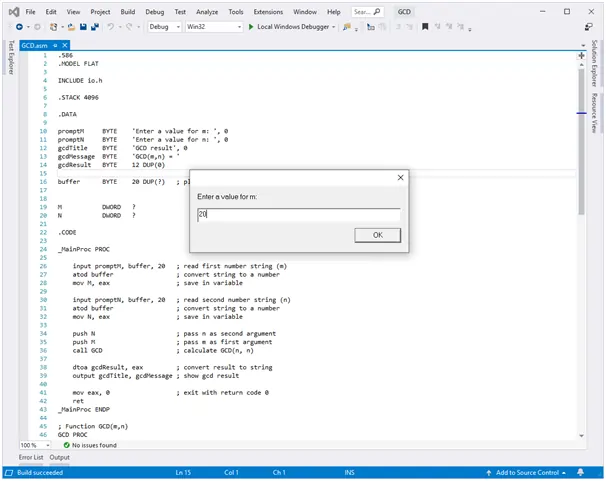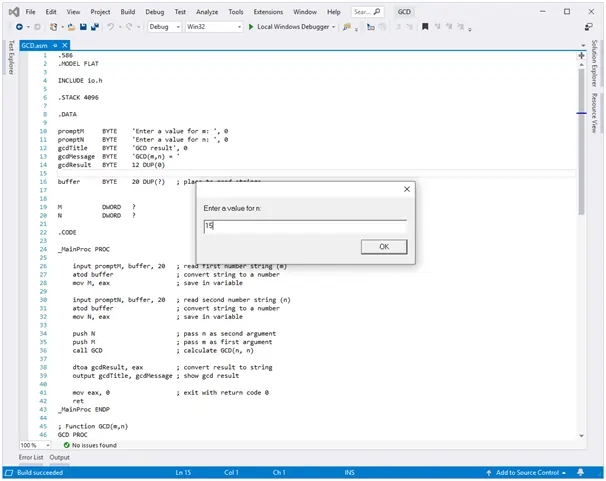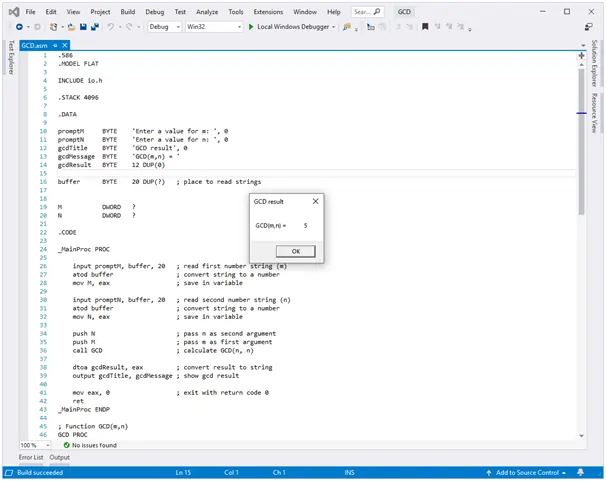Instructions
Objective
Write an x86 assignment program to create a GCD routine in x86 assembly language, using recursive algorithm.
Requirements and Specifications
The greatest common divisor (GCD of two positive integers m and n can be calculated recursively by the function described below in pseudocode. function GCD(m, n : integer) : integer; if n = 0 then return m; else Remainder : = m mod n;
return GCD(n, Remainder);end if;
Implement this recursive definition in assembly language. Use the stack to pass the two doubleword-size argument values. Return the value of the function in the EAX register. The procedure should remove the parameters from the stack. Test your function with a main program that inputs two integers, calls the greatest common divisor function CD, and displays the value returned.
Program Specification:
Basic I/O (using io.h)
- Obtaining user input
- Using an input file
- Displaying computation results
Data Types
- WORD
Basic Instructions and Computations
- mov
- cmp
- div
- mul
- push
- рор
Write procedures
- main procedure
- GCD procedure
Screenshots of output



Source Code
.586
.MODEL FLAT
INCLUDE io.h
.STACK 4096
.DATA
promptM BYTE 'Enter a value for m: ', 0
promptN BYTE 'Enter a value for n: ', 0
gcdTitle BYTE 'GCD result', 0
gcdMessage BYTE 'GCD(m,n) = '
gcdResult BYTE 12 DUP(0) ; place to save result string
buffer BYTE 20 DUP(?) ; place to read strings
M DWORD ?
N DWORD ?
.CODE
_MainProc PROC
input promptM, buffer, 20 ; read first number string (m)
atod buffer ; convert string to a number
mov M, eax ; save in variable
input promptN, buffer, 20 ; read second number string (n)
atod buffer ; convert string to a number
mov N, eax ; save in variable
push N ; pass n as second argument
push M ; pass m as first argument
call GCD ; calculate GCD(n, n)
dtoa gcdResult, eax ; convert result to string
output gcdTitle, gcdMessage ; show gcd result
mov eax, 0 ; exit with return code 0
ret
_MainProc ENDP
; Function GCD(m,n)
GCD PROC
push ebp ; save frame pointer
mov ebp, esp ; point to top of stack
push ebx ; save EBX
mov eax, [ebp + 8] ; load first argument (m)
mov ebx, [ebp + 12] ; load second argument (n)
_if:
cmp ebx, 0 ; if n == 0
je _return ; return m (is already in eax)
_else:
mov edx, 0 ; clear edx to make division
div ebx ; divide m/n
push edx ; pass remainder as second argument
push ebx ; pass n as first argument
call GCD ; recurse GCD(n, remainder)
_return:
pop ebx ; restore EBX
pop ebp ; restore frame pointer
ret 8 ; return and remove arguments from stack
GCD ENDP
END ; end of source code
Related Samples
Explore our repository of free assembly language assignment samples to enhance your understanding and excel in your programming projects. Access them effortlessly to gain valuable insights and improve your coding skills.
Assembly Language
Assembly Language
Assembly Language
Assembly Language
Assembly Language
Assembly Language
Assembly Language
Assembly Language
Assembly Language
Assembly Language
Assembly Language
Assembly Language
Assembly Language
Assembly Language
Assembly Language
Assembly Language
Assembly Language
Assembly Language
Assembly Language
Assembly Language
